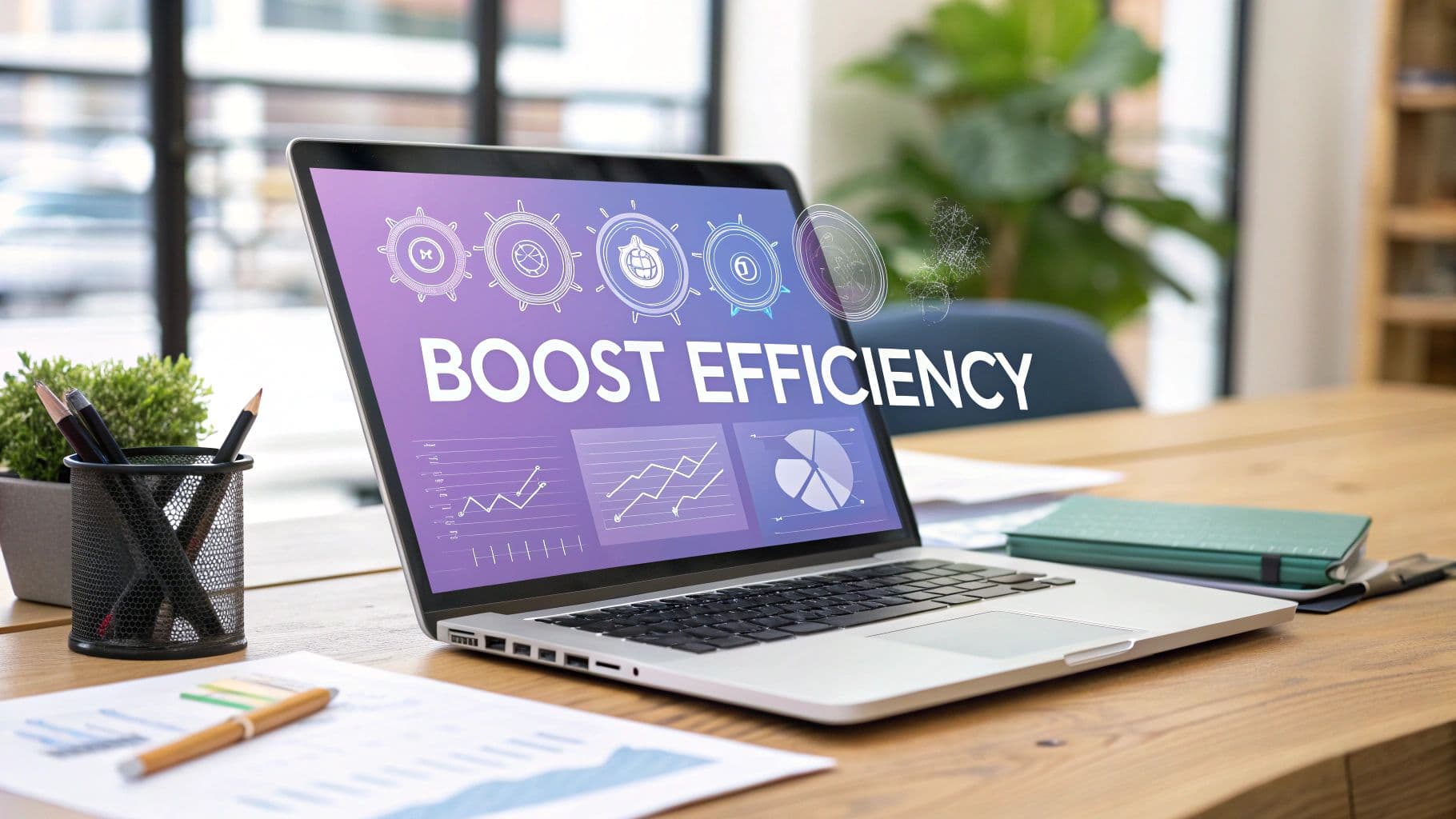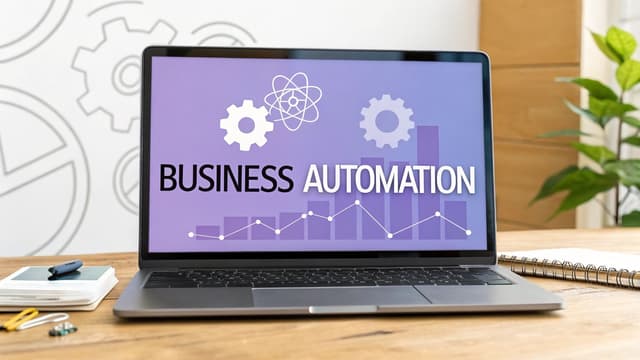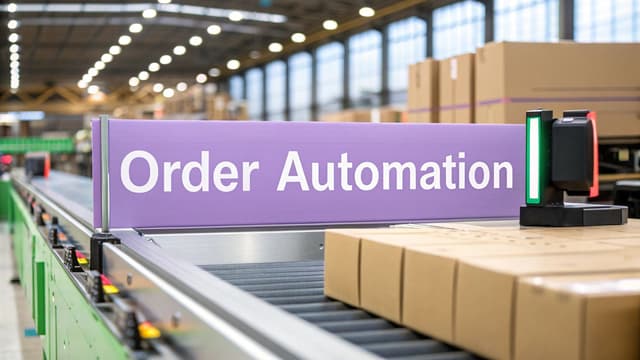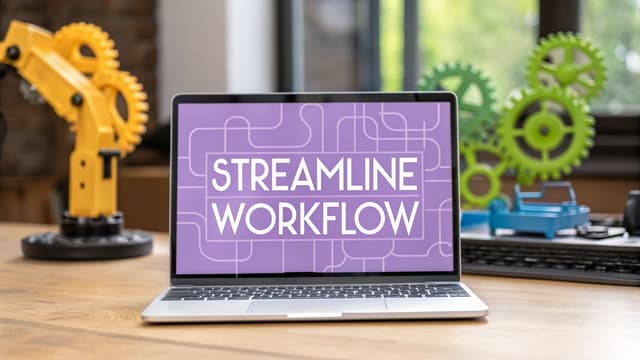When most people hear "business efficiency," they think of cutting costs. That’s the old way. It was a race to the bottom that often led to burnout and quick fixes that didn't last.
Let's be real: True efficiency isn't about doing more with less. It's about working smarter, not just harder. It’s a complete shift in mindset—from squeezing every last drop out of your resources to building intelligent, sustainable systems that maximize what you produce while cutting out the waste.
So, What Does Business Efficiency Actually Mean Today?
 Today, efficiency is about creating a resilient, agile operation. It’s a mix of clever technology and an empowered team that can spot and fix problems on the fly. You're not just looking at isolated tasks; you're looking at the entire operational picture.
Today, efficiency is about creating a resilient, agile operation. It’s a mix of clever technology and an empowered team that can spot and fix problems on the fly. You're not just looking at isolated tasks; you're looking at the entire operational picture.
Before you can really make a dent, you have to know where you stand. You need solid benchmarks. Figuring out how to measure operational efficiency with the right metrics is the critical first step. Otherwise, you're just guessing.
To build a truly efficient modern business, you need a strong foundation. This table breaks down the core strategies that form that foundation, turning abstract ideas into actionable goals.
The Pillars of Modern Business Efficiency
| Strategy Area | Primary Goal | Key Tools & Methods |
|---|---|---|
| Streamlined Core Processes | Eliminate bottlenecks and errors in key workflows. | Process mapping, workflow analysis, feedback loops, Standard Operating Procedures (SOPs). |
| Intelligent Automation | Free up human talent for high-value strategic work. | AI-powered CRMs, marketing automation software, automated invoicing, customer support chatbots. |
| Data-Driven Decision Making | Replace guesswork with insights from real-time data. | Business intelligence (BI) dashboards, analytics platforms, A/B testing, forecasting models. |
| A Culture of Improvement | Empower the entire team to drive optimization. | Regular check-ins, suggestion boxes, cross-functional project teams, incentive programs. |
Each of these pillars supports the others. You can't have great automation without streamlined processes, and you can't make data-driven decisions without a culture that values and acts on that data. It all works together.
The real goal isn't just to make things faster. It's to make them more effective. A truly efficient business is nimble enough to pivot when the market shifts, without everything grinding to a halt.
This guide is your blueprint for getting there. We’ll walk through the practical strategies you need to build a more competitive, profitable, and frankly, more enjoyable business to run—balancing powerful tech with the irreplaceable value of your people.
Automate Your Operations to Reclaim Time
Think about the repetitive, soul-crushing tasks that bog down your team every day. These operational bottlenecks are silent profit killers, draining energy and pulling focus away from work that actually drives growth. The first real step toward better business efficiency is to hunt down and eliminate these drags on your time.
A simple workflow audit is the best place to start. Map out a core process from A to Z, whether it's processing a new sales order or onboarding a client. Get granular. Document every single touchpoint and task. As you lay it all out, you'll immediately spot the delays, the mind-numbing data entry, and the clumsy manual handoffs. This diagnosis gives you a crystal-clear roadmap for where automation will make the biggest splash.
Pinpoint and Prioritize Automation Opportunities
Once you’ve identified the pain points, you can find the right tools for the job. You don't need a massive, complex enterprise system to see results. In fact, you can get started with accessible platforms like Zapier or Make that let you connect the apps you already use to create automated workflows—no coding required.
Here are a few common scenarios just begging for automation:
- Invoice Processing: Automatically generate and send an invoice the moment a project is marked "complete" in your project management software.
- Customer Follow-up: Trigger a personalized email sequence to go out a week after a customer's purchase.
- Data Entry: Sync customer info from a website form directly into your CRM, cutting out manual input entirely.
This simple framework shows how to find and fix these operational drags. It’s a continuous cycle: you map what you're currently doing, find the weak spots, and roll out targeted solutions. That new, improved process then becomes the new baseline to monitor.
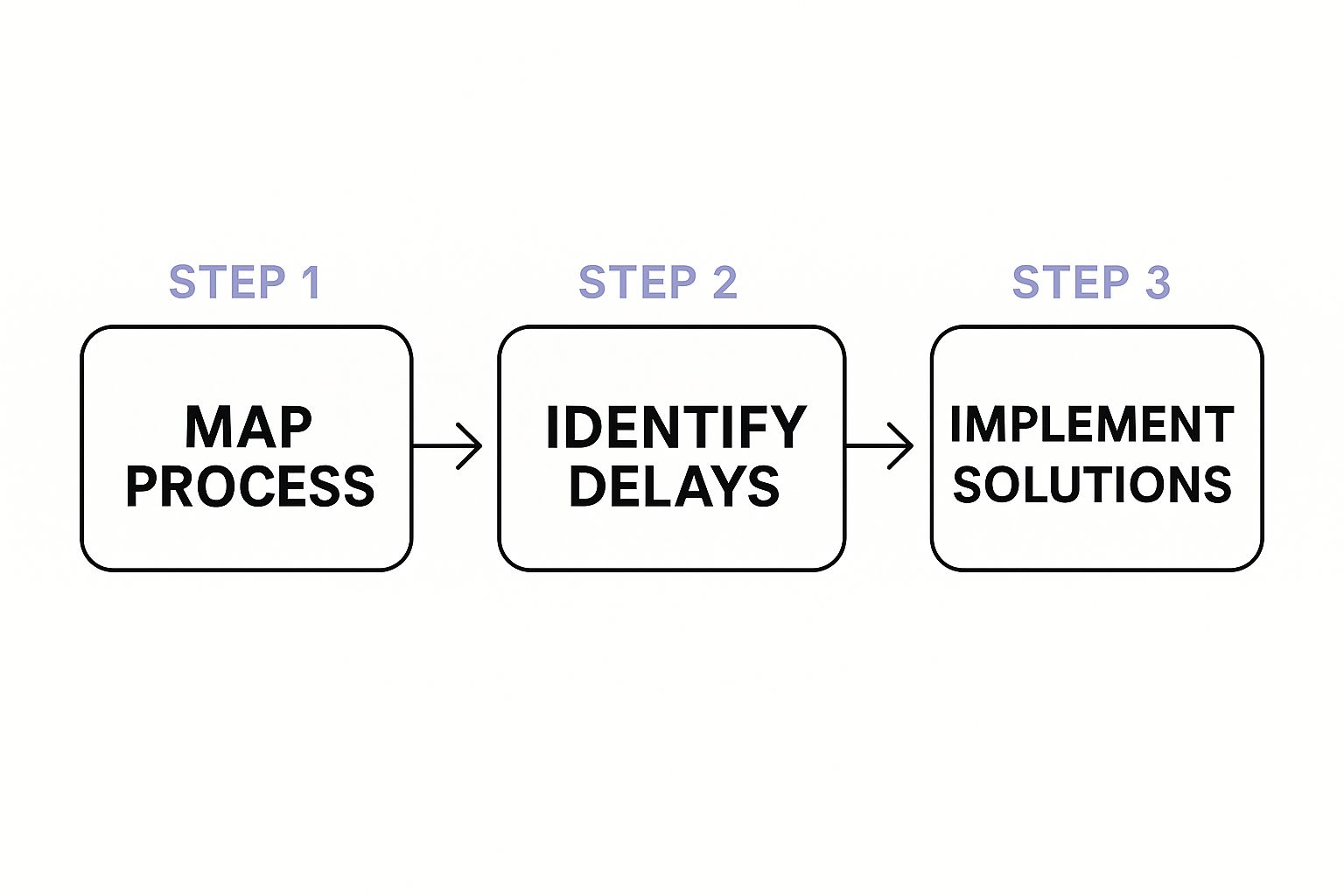
Implement Accessible Automation Tools
The goal here is to make your existing tools talk to each other and work together seamlessly. Modern automation is all about building these bridges between the software you rely on daily, creating a single, efficient system. You can explore a ton of practical business process automation examples to get a feel for what’s possible.
The impact of this approach is huge. On top of the time savings, studies show that automation tools can cost as little as one-fifth of an onshore employee. It also has a massive effect on morale. A staggering 89% of employees report higher job satisfaction after automation is introduced, mainly because it gets rid of the boring stuff and reduces the risk of burnout.
By automating routine operations, you're not just saving time and money. You are fundamentally changing what your team is capable of achieving, freeing them up for strategic thinking and high-impact work.
Especially in today's world, it's critical to Boost Productivity in an Asynchronous Work Environment, where clear, automated workflows are the glue that keeps everyone aligned and productive, no matter where or when they're working.
Unlock Productivity Gains with Practical AI
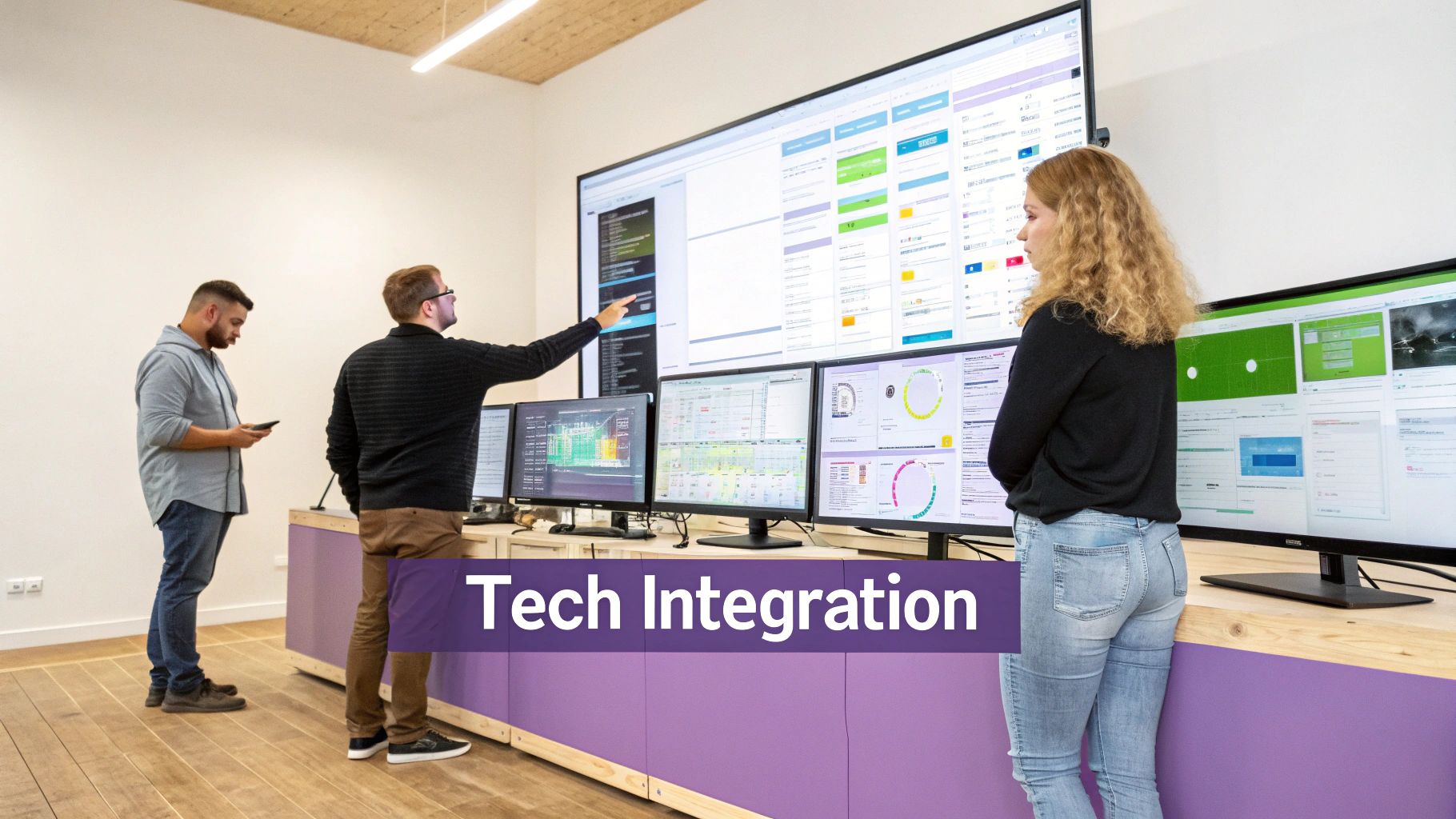
Let's move beyond basic automation and talk about Artificial Intelligence. When most people hear "AI," they think of futuristic robots, but the reality is much more practical and already here. It’s embedded in software that can help businesses like yours work smarter, not just harder.
Think of it as giving your team superpowers—the ability to spot trends, optimize complex schedules, and blast through administrative tasks that used to eat up their day.
Adopting AI isn't some fringe strategy anymore; it's quickly becoming essential for improving business efficiency. The numbers don't lie. AI adoption is on track to hit 72% among companies by 2025, a huge leap from around 50% in previous years. Even more telling, a staggering 92.1% of businesses say they've seen real, measurable productivity gains after bringing AI on board. If you want to dig into the data, Superhuman has some great AI insights and stats.
Identify Where AI Can Make an Impact
So, where do you start? The trick is to apply AI where it solves tangible problems. You don’t need a team of data scientists to get going. Just look for common areas in your business where AI-powered tools can offer immediate value.
Here are a few ideas to get you thinking:
- Advanced Data Analysis: AI can dig through massive amounts of data to find market trends, customer behaviors, or operational bottlenecks that a human would likely miss. This lets you make decisions proactively instead of just reacting.
- Intelligent Scheduling: If you run a business with complex logistics—say, a field service company—AI can optimize technician routes in real-time. It can account for traffic, job duration, and appointment priority to squeeze in more jobs per day.
- Automated Customer Support: AI-driven chatbots are a classic example. They can handle routine questions instantly, 24/7, which frees up your human agents to focus on the complex, high-touch issues where they really shine.
AI's true power isn't in replacing people, but in augmenting their abilities. It handles the repetitive, data-heavy lifting, allowing your team to focus on creativity, strategy, and building customer relationships.
Putting AI to Work in Your Business
Ready to jump in? A great first step is to look at the tools you already use. Many modern CRM and marketing platforms now have built-in AI features for things like lead scoring, email personalization, or content ideas. Often, just flicking these on is the easiest way to start.
For your customer-facing teams, specialized AI agents can be a total game-changer. These tools plug into your existing systems to provide instant, human-quality support on your website, WhatsApp, or other channels. For example, you can boost business performance with analytics for chatbots to get a much deeper understanding of what your customers need and how you can improve your support.
The data is clear: businesses that adopt AI early are seeing huge benefits. 56% of them are exceeding their business goals, compared to just 28% of those still stuck in the planning phase. By bringing practical AI into your operations, you’re not just chasing a buzzword—you’re building a smarter, more responsive, and more competitive business.
Build Long-Term Efficiency Through Sustainability

For a long time, business leaders have treated "sustainability" like a line item on the marketing budget—a nice-to-have for brand image, but ultimately a cost center. That way of thinking is officially obsolete.
Today, smart companies are realizing that sustainability isn't an optional extra. It’s a core strategy for building a leaner, more resilient, and ultimately more profitable operation. This isn't about feeling good; it’s about making your business fundamentally better.
Think about it: when you focus on cutting waste, you're also cutting wasted money. When you use fewer resources, you lower your operational costs. This is how you build genuine business efficiency that lasts.
Adopt Circular Economy Principles
The circular economy model is a perfect example of this in action. The old model was simple: take, make, and dispose. A circular approach, on the other hand, focuses on keeping materials and products in use for as long as possible. This is a game-changer. It directly slashes raw material costs and can even open up entirely new revenue streams.
Look at an outdoor brand like Patagonia. Their repair and resale programs are legendary. They're not just extending a product's life; they're creating a secondary market that boosts brand loyalty and generates income from items that would have ended up in a landfill.
This mindset has gone mainstream. Companies are now embedding Environmental, Social, and Governance (ESG) practices directly into their operations. This reflects a global shift in understanding that sustainability and efficiency are two sides of the same coin. In fact, it's one of the key 2025 business trends identified on Quantive.com.
The smartest efficiency gains come from rethinking your entire value chain. By designing waste out of your processes from the start, you build a more durable and cost-effective business model.
This thinking applies directly to the supply chain. Better inventory management, a key part of sustainability, also prevents over-ordering and waste. For instance, robust order management automation gives you the real-time data needed to maintain perfect stock levels, reducing both carrying costs and the risk of dead stock.
Implement Greener Technologies
Another powerful way to merge sustainability with efficiency is through greener technologies. And no, this isn't just about putting solar panels on the roof (though that can be a great move). It's a broad strategy that can touch every corner of your business.
Here are a few practical examples I've seen work wonders:
- Smarter Energy Use: Switching to energy-efficient LED lighting and installing smart thermostats are easy wins that can slash utility bills. For bigger operations, investing in renewable energy sources can lock in predictable energy costs for years to come.
- Better Waste Management: Using biodegradable packaging doesn't just appeal to eco-conscious customers; it can dramatically cut your waste disposal fees.
- Fleet Operations: If your company runs delivery vehicles, moving to electric or hybrid models is a no-brainer. It cuts fuel costs and significantly reduces long-term maintenance needs.
These aren't just environmental victories. They are savvy financial decisions that create lasting operational improvements. When you start viewing sustainability through the lens of efficiency, you future-proof your business against rising costs and shifting consumer demands—all while boosting your bottom line today.
Empower Your Team with the Right Tools and Training
Let's be honest. All the shiny new tech and automation in the world won't do you much good if your team isn't on board. Technology is just a tool. Your people are the ones who actually make your business run.
I've seen it happen time and time again: a company invests a small fortune in a sophisticated new platform but then cuts corners on training, assuming everyone will just "get it." It's a recipe for disaster. That amazing software ends up collecting dust, adoption rates plummet, and the promised ROI never materializes.
To really get the most out of your investments, you have to equip your people with two things: the right tools and the knowledge to use them well. This is where modern digital platforms, like comprehensive CRM platforms, can be a game-changer. They centralize client data and create a single source of truth, tearing down the data silos that kill collaboration and efficiency.
Invest in Continuous Learning and Skill Development
Technology moves fast. The skills that were essential last year might be outdated by next quarter. That’s why ongoing training isn’t a luxury—it’s a necessity for staying competitive and keeping your team engaged.
When you roll out a new tool, don't just dump everyone into a single, overwhelming 4-hour training marathon. That’s a surefire way to make people tune out.
Instead, think in smaller, more targeted chunks. Here’s a framework I’ve found works much better:
- A Quick Kickoff: Start with a one-hour session covering the absolute core features everyone needs for their day-to-day work.
- Role-Specific Workshops: Follow up with shorter, 30-minute sessions designed for specific teams. How sales uses the tool is completely different from how marketing will.
- "Office Hours" Q&A: Schedule an open Q&A session a couple of weeks later. This gives people a chance to ask real questions that have popped up while they've actually been using the tool.
This approach makes learning manageable and immediately relevant. When your team feels confident with their tools, they’ll actually use them to their full potential. That's where you see real productivity gains.
Building a culture of continuous improvement is the most sustainable way to enhance business efficiency. When every team member feels empowered to identify bottlenecks and suggest better ways of working, you unlock a powerful, distributed engine for optimization.
Foster a Culture of Improvement and Ownership
Beyond formal training, the real secret to empowering your team is giving them a genuine sense of ownership. Nobody knows the little frustrations and friction points in a process better than the people doing the work every single day.
You need to actively encourage them to speak up.
Create dead-simple channels for feedback. It could be a dedicated Slack channel or a monthly "what can we fix?" brainstorming meeting. The key is to make it easy and accessible.
And when an employee points out a real problem or suggests a smart fix? Act on it. Then, publicly acknowledge their contribution. This creates a powerful positive feedback loop, showing everyone that their insights are not only welcome but valued. It motivates others to get involved.
Finally, set clear goals that resonate with your team. They need to understand why efficiency matters—not just for the company's bottom line, but for their own sanity and success. When people see how a smoother process makes their own job less stressful, they become active partners in the mission.
This is how you turn your team into an unstoppable force for efficiency. It all starts with trust, training, and giving them the autonomy to do their best work.
Look, as you start digging into ways to make your business run smoother, you're going to have questions. Everyone does. Instead of letting those "what ifs" paralyze you, let's just get straight to it and tackle them head-on.
Getting stuck in the weeds of how to begin can kill your momentum before you even start. My goal here is to give you some clear, no-nonsense answers so you can move forward with confidence and actually see some results.
Where Do I Even Start to Improve Business Efficiency?
The best place to start, almost without fail, is a process audit. Seriously. Before you even think about shopping for new software, you have to get a handle on what’s actually happening in your business right now. Take one of your core workflows—like how you get a new lead, fulfill an order, or onboard a new client—and map it out from start to finish.
And don't do this in a vacuum. Pull your team in. They’re the ones in the trenches every day, and they know exactly where the friction points are. As you map everything out together, the weak spots will jump right out at you:
- Mind-numbing repetitive tasks that someone is still doing by hand.
- Bottlenecks where work just sits and piles up, waiting for an approval.
- Areas where mistakes happen over and over, forcing you to do the work twice.
This simple diagnostic exercise gives you a real, prioritized roadmap. You can then zero in on the areas that will give you the biggest bang for your buck first. Nailing a quick win builds momentum and gets everyone excited for what's next.
The point of an audit isn’t to point fingers; it's to find opportunities. A clear picture of your current state is the single most valuable thing you can have when you start this journey.
How Can a Small Business Possibly Afford All These Efficiency Tools?
This is a huge, and totally valid, concern. But here’s the good news: you don’t need a Fortune 500 budget to get your hands on incredibly powerful tools anymore. The explosion of Software-as-a-Service (SaaS) has completely changed the game for small and medium-sized businesses.
Most of the best modern tools are built to grow with you. You want to look for platforms that offer:
- Tiered Pricing: You only pay for what you need today, with an easy path to upgrade as your business expands.
- Freemium Models: So many great tools have generous free versions that are more than enough for small teams or for solving one specific problem.
- Free Trials: Take the software for a proper test drive. Get your team using it and see if it actually fits your workflow before you spend a dime.
Start small. Pick one high-impact problem and find a targeted solution. Maybe that's using Trello to get a handle on project chaos or using Zapier to connect two apps you're already paying for. The time you save—even with a small, affordable tool—often pays for itself almost immediately, freeing up cash and mental energy for the next project.
Isn't AI Too Complicated for a Non-Technical Business?
Not anymore. This is probably the biggest misconception holding businesses back right now. The idea that you need a team of data scientists on staff to benefit from AI is completely outdated. The truth is, most of the software you're considering already has user-friendly AI baked right in.
You’re probably already using AI and don't even think about it. Your email filters spam using AI. Your CRM might use AI to score leads. The trick is to focus on adopting tools that have these AI features built-in, rather than trying to build some complex system from the ground up. It's the simplest and most effective way to get access to some seriously powerful technology.
Ready to deploy intelligent AI without the complexity? FlowGent AI lets you build and launch powerful AI agents across your customer-facing channels—no coding required. From answering questions on your website to managing orders via WhatsApp, our platform handles it all, 24/7. See how easy it is to improve your business efficiency at https://flowgent.ai.
